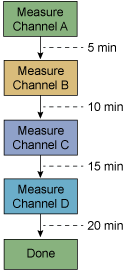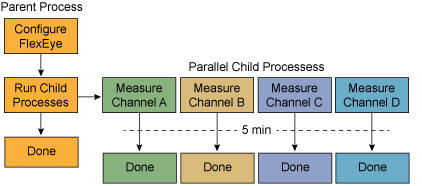FlexEye Streaming
Eye mode's FlexEye Independent Eye Acquisition streaming feature allows you to treat a multi-channel DCA-M module or a DCA-X as independent single-channel DCAs, from a functional and programmatic perspective. FlexEye requires a single timebase setup (symbol rate) but not a single timebase. As a result, you can use combinations of multiple DCA-X and DCA-M channels, including multiple DCA-Ms. For example, when using a four-channel N1092D the following tasks could run simultaneously:
- Channel A performing an autoscale,
- Channel B performing a laser tuning operation,
- Channel C collecting data for a mask test, and
- Channel D saving screen captures.
Each channel has an independent remote SCPI interface. As this example illustrates, FlexEye offers process, performance, and compatibility advantages.
SIRCLP (SIRC on Long Patterns) is compatible with FlexEye streaming.
Process Advantage
Consider the case of a four-channel DCA-M or DCA-X that is used to test four single-channel devices. The traditional measurement approach without FlexEye would follow these steps:
- Simultaneously connect all 4 devices.
- Simultaneously collect identical amounts of data for all channels.
- Make the measurements.
- Save the results.
Using FlexEye, this process can be staggered. While one device is being connected, the other 3 channels can be collecting data and making measurements. In addition, there is no requirement for every channel to collect the same amount of data. For example, one channel can perform a mask test against 1,000,000 samples, while the next channel can choose to collect only 300,000 samples. This independence allows you to optimize the utilization of your DCA-M or DCA-X into your process.
Performance Advantage
The traditional measurement approach for multi-channel instruments suffers from the following bottlenecks:
- Setup. All channels need to be connected, configured, and autoscaled at the same time. This is a bottleneck with physical resources and instrument hardware.
- Communication. All channels are configured via a single SCPI interface. this can be a bottleneck on the instrument's SCPI server or the client's SCPI library.
- Measurements. Since all data is collected at the same time, all measurements are performed at the same time. This creates a bottleneck in the instrument's measurement CPU.
- Saving results. Because there is only a single display, archival waveform screen captures must be configured serially to show each channel prior to capturing the display.
FlexEye's independent SCPI interfaces, independent acquisition control, independent measurement analysis, and independent graphical user interfaces eliminates all of the above bottlenecks.
Compatibility Advantage
Frequently, test and measurement engineers must adapt an existing process (including software) that was created for single channel instruments for use with a multi-channel instrument. This task can be very difficult. However, because FlexEye presents each channel as a single-channel instrument, the time required to integrate the multi-channel instrument into an existing process is greatly reduced.
Supported features:
- PAM4 and NRZ signals
- Pattern lock
- Rapid eye (faster acquisition
with pattern lock off) - Masks testing
- Math functions
- TDECQ measurements (and other
measurements that require pattern lock) - SIRCLP (SIRC on Long Patterns)
Run from:
- FlexDCA FlexEye Streaming Setup
dialog, or - SCPI commands
in the FlexDCA Programmer's Guide for the:FEYESCPI subsystem.
To configure FlexEye from FlexDCA's graphical user interface, use the FlexEye Streaming Setup dialog. To remotely configure and run FlexEye, use the commands in the FlexDCA Programmer's Guide for the :FEYE SCPI subsystem. The independent FlexEye sampling oscilloscopes are configured as sessions. FlexEye sessions can be in one of two states: running or paused. This is explained in the FlexEye Stations topic.
Starting with FlexDCA revision A.05.80, the FlexEye Streaming feature became compatible with pattern lock (pattern triggering).
You can use SIRC (System Impulse Response Correction) if you use SIRCLP (System Impulse Response Correction for Long Patterns).
Example
As an example of using FlexEye, let's say that you wrote a program that measures the change in eye width over 5 minutes and that you need to run this measurement on four channels (four DUTs). Traditionally, you would perform each measurement sequentially for a total test time of 20 minutes. With FlexEye, these same measurements can be performed asynchronously by launching four asynchronous child processes. As all measurements are simultaneously run, the total test time for all channels is just slightly over 5 minutes. There is a Python example program in the FlexDCA Programmer's Guide that demonstrates just such a task.
| Traditional (Synchronous Measurements) |
With FlexEye (Asynchronous Measurements) |
|
|---|---|---|

|

|